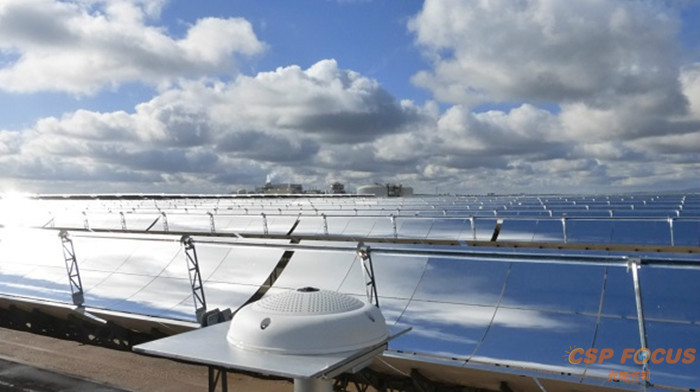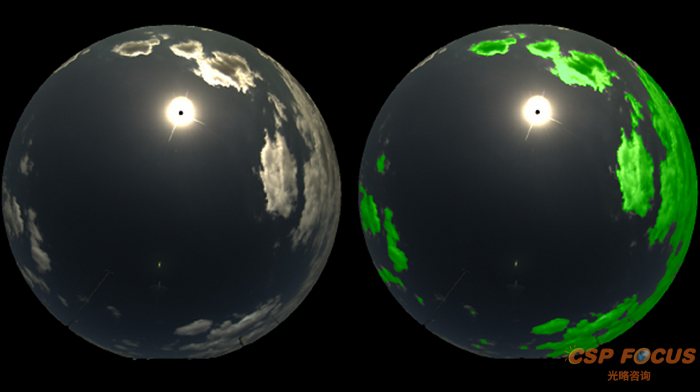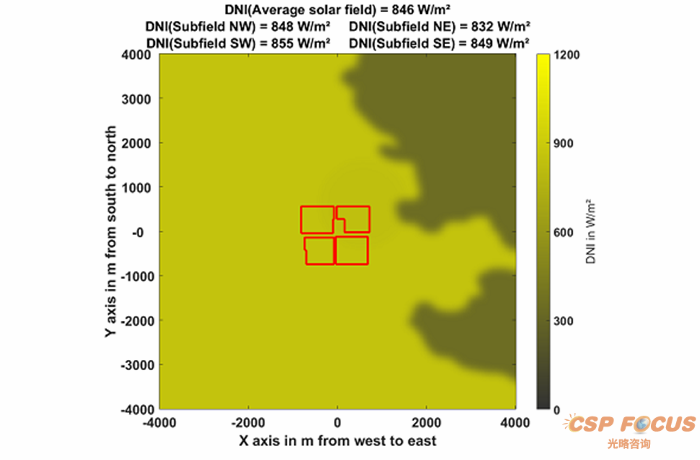Home > Market > Other Regions > Here
Cloud camera system WobaS provides concentrated solar power plants with reliable radiation nowcasts
2019.09.17 From: DLR
The
cloud camera system WobaS predicts the solar radiation in the next
fifteen minutes. The system has been developed by the DLR Institute of
Solar Research together with CSP Services GmbH and TSK Flagsol
Engineering GmbH. It provides temporally and spatially highly resolved
information on the solar irradiance based on several cloud cameras. The
software in the control room of the power plant can then derive the
expected available energy and adapt the operation.

All sky camera in the parabolic trough plant La Africana. Source: DLR (CC-BY 3.0)
The
nowcasts are valuable in two ways for a CSP power plant (Concentrating
Solar Power = CSP). For example, to avoid thermal stress on components
as a result of extreme temperature changes, the control system has the
option of defocusing the collectors. Refocusing takes time, wasting
valuable solar energy. WobaS enables to control the power
plant proactively without defocusing and losing any energy. «The
integration of such a forecasting system in a parabolic trough system
allows us, for instance, to regulate the flow of heat transfer medium in
the power plant such, that all collectors remain focused even with
fluctuating solar radiation. Thus they achieve the best performance,
reports project manager Dr. Tobias Hirsch.

Left: Picture of a cloud camera. Right: Presentation of automatically detected clouds.
The
natural variability of solar radiation often causes fluctuations in
power grids. The data from WobaS enable a more efficient feed-in of
solar power into the power grid. In particular, rapid changes of the
feed-in within short periods, so-called «ramps», can be predicted more
accurately.

Local irradiation map in W/m2. The outlines of the power plant are shown in red.
If
the power plant uses the information provided by WobaS, both the
electricity production of the power plant and the service life of the
power plant components can increase. «We expect that the use of
spatially resolved radiation information at the time of image
acquisition will increase the yield of the parabolic trough plants by
two percent. If the power plant is also controlled using radiation
prediction, further increases in yield are possible», says Dr. Stefan
Wilbert, Head of the Solar Energy Meteorology Group at the Institute of
Solar Research. The researchers will present the corresponding results
at the SolarPACES conference in autumn.
The WobaS system consists
of two to four cloud cameras and an evaluation unit. Each of the
cameras uses a calibrated 180-degree fisheye lens to take pictures of
the clouds above the solar field and its surroundings. Special software
uses these pictures to derive cloud properties such as location, height,
shape and transmittance as well as their direction of movement and
speed. In combination with the existing measured irradiance at the power
plant, the WobaS system calculates a map of the current irradiance on
the solar field and forecasted maps for the following fifteen minutes.
Every 30 seconds, the cloud camera system provides updated radiation
maps.
In 2017, engineers tested the system in the commercial
solar power plant «La Africana» in Spain in real operation. The WobaS
project was successfully completed in 2018. The WobaS system has been
installed in two locations in Spain as well as in the Jülich solar tower
and in a CSP test facility in Évora, Portugal. CSP Services GmbH offers
the WobaS system commercially for CSP as well as for PV power plants.
Another application after slight modifications is the research network
eye2sky of DLR’s Institute for Networked Energy Systems. More than 30
camera stations are investigating the influence of the weather on the
power grids in the region around Oldenburg.
After the development
and successful demonstration of the system, the follow-up project
WobaS-A puts the emphasis on the application of radiation forecasts. In
addition to the application in solar thermal power plants, the focus is
also on the application in photovoltaic (PV) power plants.
The
main goal of the BMWi funded WobaS-A project is the development of
innovative, prediction-based operating strategies for solar power
plants. The extensive data sets with real measured, high-resolution
radiation data is used as a basis.
Furthermore, the project
WobaS-A aims to establish an interface to the HeliOS heliostat field
control for solar tower power plants developed at DLR, which enables the
cloud camera forecast data to be transmitted online. HeliOS uses this
information to calculate how the mirrors need to be positioned to
maximize the profits. A combination of HeliOS and WobaS could make a
solar power plant even more efficient.
CSP-Services already
offers cloud camera systems on the market. DLR and its industry project
partners will integrate the findings of the WobaS-A project into the
current system so that CSP and PV power plants can benefit from the
results. The researchers are currently simulating the operation of a
parabolic trough system using the information from WobaS. The aim is to
make the control concept of the solar power plant more intelligent and
to further increase the efficiency. The next step is to test the
prototype of this operating strategy in a parabolic trough test
facility. After the successful demonstration, it will be transferred to
the control center of a commercial power plant. A forecast system in a
commercial PV power plant is also planned to demonstrate the benefits of
radiation forecasts for PV and to enable optimized operating strategies
(e.g. in association with storage).
Starting summer 2019,
scientists from various international research centers, universities and
companies will compare their cloud camera systems at CIEMAT’s
Plataforma Solar de Almeria in Spain. The developers want to use the
results to further improve their respective systems.
Upcoming CSP events:
3rd CSP Focus Innovation 2019(Oct.24-25, Beijing China)
10th CSP Focus China 2020 (March, Beijing China)
More CSP news and reports please visit www.cspfocus.cn
or CSP Focus social media on LinkedIn, Twitter, Facebook.
More from CSP Focus
NextNoor III CSP tower seen as 'tipping point' for financing costs
TEWER HAS DESIGNED AND DEVELOPED A NEW INTELLIGENT HELIOSTAT
U.S. Secretary of Energy announces $24 million in Concentrated Solar Power R&D funding
China-made Long shaft molten salt pump successfully applied in Hami CSP Tower Project
Hawaii receives $1.9M in federal funding to test solar-thermal desalination on Big Island
ContourGlobal closes sale of 49% stake in Spanish 250MW CSP portfolio
Leave your thoughts here
Reports(Member Only)
See more+-
CSP Focus Membership Proposals
We are now proposing CSP Focus Membership, hoping to better serve our members to keep pace with the latest updates of ongoing CSP projects worldwide, and to establish and maintain business relations with major shareholders of the projects. CSP Focus offers to Membership exclusive access to:1. Daily/Weekly update and analysis on CSP policies, projects, technologies, market trend and corporate relea
-
The Latest CSP Focus Monthly Update
Join CSP Focus Membership to Get the Latest CSP Focus Monthly Update December Edition.
-
CSP Project Monthly Update 2022 December Edition
CSP Focus is presenting CSP Project (China) Update 2022 December Edition.Detail report is available for CSP Focus Membership.
-
Presentations-CSP Focus China 2021
The Report is for CSP Focus Members only.
Upcoming Events
See more+-
12th CSP Focus China 2022
2022.04.21-22 Beijing
-
11th CSP Focus China 2021
2021.10.28-29 Beijing
-
10th CSP Focus China 2020
2020.10.22-23 Beijing, China
Project Updates
See more+-
Lanzhou Dacheng Dunhuang CSP Project
Asia Pacific-China,Operational,Parabolic Trough
-
Luneng Haixi 50MW Molten Salt Tower CSP Project
Asia Pacific-China,Operational,Power Tower
-
Dubai 950MW NOOR Energy 1 CSP+PV Project
MENA-UAE,Under construction,Power Tower
-
Power China Gonghe 50MW Molten Salt Tower CSP Project
Asia Pacific-China,Operational,Power Tower





